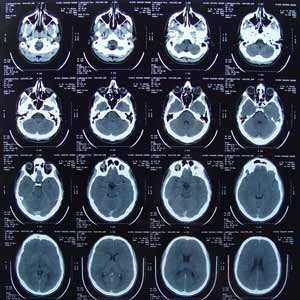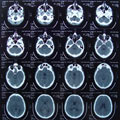Description of the test
A computerized tomography scan (CT or CAT scan) is a test that produces a series of X-ray images of the body. The CT scanner passes X-rays through the body and produces cross-sectional pictures so each picture is a "slice" of the body. The images can be combined by a computer to create three dimensional images of internal organs and body structures.
The CT scan produces images that are more detailed than conventional X-ray films. Compared to plain X-rays, CT scans allow doctors to better detect and localize abnormalities of the various organs and tissues of the body using extremely accurate images.
How often should the test be performed?
Your doctor will recommend when and how frequently this test is required.
Why is this test performed?
CT scans are performed to help the doctor to study various parts of the body and identify and monitor medical problems.
CT scans can be performed for many areas of the body, including the:
- head and neck, which can reveal injuries, tumours, strokes, infections, bleeding, and blood vessel abnormalities
- spine, which may show fractures, tumours, weakened bones, or deformities
- chest, which can reveal infection, tumours, and bulges in blood vessels (aneurysms)
- abdomen and pelvis, which may show infections, injuries, tumours, and inflammatory conditions
CT scans can also be used to help doctors perform medical procedures or treatments that require high accuracy. Examples of these medical procedures include surgery, biopsies, radiation therapy, removal of fluid from organs, and drainage of abscesses.
Are there any risks and precautions?
Although a CT scan is considered safe, it does have some risk of side effects or complications because it involves radiation exposure. Though rare, side effects or complications include:
- radiation exposure: This can potentially increase your risk of developing cancer, but the valuable information obtained generally outweighs the risks. The risk is higher in children, young adults, and people who have had multiple radiation tests. A CT scan is usually not performed during pregnancy because of the risks to the developing fetus. If you are or may be pregnant, inform your doctor and discuss all the risks and benefits of a CT scan, as well as other alternatives such as ultrasound or magnetic resonance imaging (MRI).
- allergic reaction to the dye used for some CT scans: Most of these reactions are mild and only result in hives or itchiness, but in rare cases they may become life-threatening. A radiologist or technologist will ask you about your medical history and allergies to determine if you are at risk of having an allergic reaction.
- kidney damage caused by contrast dye: This may be a risk for people with poor kidney function, heart disease, asthma, dehydration, diabetes, or who are taking metformin. If you have diabetes or kidney problems, talk to your doctor before having a CT scan.
CT scans may possibly interfere with medical devices such as pacemakers and insulin pumps.
What happens during the test?
This test is painless. You will be asked to lie very still on a table. The table will pass through a doughnut-shaped machine. This machine will rotate around the table to take many X-ray images at different angles.
The test will take 30 to 60 minutes depending on the part of the body being examined. A technologist will be available to you through an intercom.
Sometimes, a dye containing iodine is injected into the blood during a CT scan. The dye can also be taken by mouth or through a rectal tube. The dye helps make blood vessels and certain organs in the body more visible for the CT pictures.
How should I prepare for this test?
Before having this test, discuss the advantages, disadvantages, long-term risks, and consequences associated with the test with your doctor. Be sure you fully understand what will happen and are comfortable with your doctor's answers to your questions.
Your doctor may tell you not to eat or drink fluids for a few hours before the test, depending on which part of your body is being scanned. For some CT scans, you may be required to take a laxative or use an enema. You may be asked to arrive early for your scheduled appointment to be given a dye to improve the clarity of the X-ray images. The dye may be given by intravenous injection, by mouth, or into the rectum.
You might feel cold lying on the CT table. Other people feel anxious or claustrophobic inside the scanner. If this happens, you might be given a sedative to help you relax.
Tell your doctor or prescriber about all prescription, over-the-counter (non-prescription), and herbal medications that you are taking. Also tell them about any medication allergies and medical conditions that you may have.
Ask your doctor or pharmacist whether you need to stop taking any of your medications before the test.
You will be asked to remove all metal objects before having the scan, including jewellery. These objects interfere with the clarity of the X-ray images.
What can I expect after the test?
You can return to your normal activities after the CT scan has been completed.
If you have received a sedative to help you relax during the scan, you should not drive until the effects of the sedative wear off. Therefore, you may need someone to take you home. If you were given a contrast dye, you may be told to drink lots of fluids to help your body flush out the material.
Results
The results of the CT scan are images that can be displayed on a computer screen or permanently recorded on film. The radiologist will review the scan and send a report to your doctor. Sometimes a specialist will also review your scans. It may take several days to prepare the complete report before it is sent to your doctor.
Ask your doctor when your test results should be available. Your doctor can discuss these with you.
All material copyright MediResource Inc. 1996 – 2024. Terms and conditions of use. The contents herein are for informational purposes only. Always seek the advice of your physician or other qualified health provider with any questions you may have regarding a medical condition. Source: www.medbroadcast.com/procedure/getprocedure/CT-Scan



